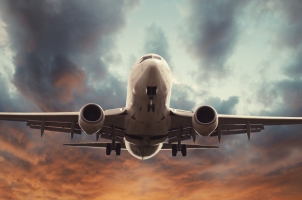BYU Study Finds Unexplored Link Between Airlines’ Profitability And Their Accident Rates

PROVO, Utah – Feb 8, 2012 – Airlines' accident risk is highest when they are performing very close to their financial targets, according to a study by a professor in BYU's Marriott School of Management.
"The accident risk went down as they got further away from their financial goals in either direction," said Peter Madsen, assistant professor of organizational leadership and strategy. "Speaking generally, airlines are safest when their financial performance is either much better or much worse than it has been in the recent past."
The study will be published in a forthcoming issue of the Journal of Management, and is available online via the journal's "OnlineFirst" feature. It looked at 133 U.S. airlines from 1990 to 2007.
Madsen's complex statistical analysis showed that for every 10 percent deviation in an airline's actual financial performance from its profitability goal, there is a 7 percent decrease in the likelihood of an accident.
The results could be useful for airline managers and for regulators, who consider issues that affect millions of flights.
"I don't think people are saying consciously, ‘We really want to hit this financial target, let's cut back on our safety expenditures,'" Madsen said. "But it's well documented that people will take risks to achieve goals, even if they don't realize they're doing it. Just being aware of these findings, and when you are close to hitting your targets, reminding people that safety is your number one concern, could reduce that tendency."
Additional financial incentives for safety "aren't a silver bullet," said Madsen, who has researched that subject. But they can balance the significance of financial or operational goals in employees' minds.
As for regulators, "this is an incredibly safe industry, so if we want to target the resources we spend on regulating it more effectively, we might want to focus on airlines performing close to their financial goals."
It's important to note that the risks Madsen studied are already miniscule.
"First-world airlines are almost incomprehensibly safe," he said, citing other research that reported a passenger would take a domestic flight every day for 36,000 years, on average, before dying in a crash. "It would be a mistake for anyone to use my findings to try to decide which airline to fly with."
Previous research into the link between profitability and safety in airlines has been inconsistent and even contradictory, typically seeking to explain the relationship in a"linear"fashion. Some studies found that safety improved as profits went up, others found that safety declined as profits went up. Madsen believes the new study identifies a better model for the effect of profitability on safety that could apply to lots of industries.
Madsen, who studies risk-taking in many industries, chose to focus this study on the airline industry because it's relatively easy to get lots of data about it. Even privately held airlines are required to disclose financial results, and the National Transportation Safety Board meticulously logs accidents.
During the period studied, the NTSB reported 915 accidents, which include death, serious injury or structural damage to aircraft. These ranged from fatal crashes to a plane being struck by a baggage cart. To double-check his results after his initial findings, Madsen ran his analysis again using airline "incidents," which are more broadly defined non-accidents that could affect the safety of the aircraft. The FAA reported 5,829 incidents during the period studied. The results held up.
"There was a very strong empirical pattern," Madsen said. That's why, although he did not examine data from other industries that have the potential to critically impact people's safety, he believes the findings apply to them as well – nuclear power, mining, maritime transportation, and more.
"It's quite likely you'd see the same pattern in other industries," Madsen said. "If anything, I think the airline industry is a conservative test because it is so safe and highly regulated."
Media Contact: Michael Smart (801) 422-7320
Writer: Michael Smart



